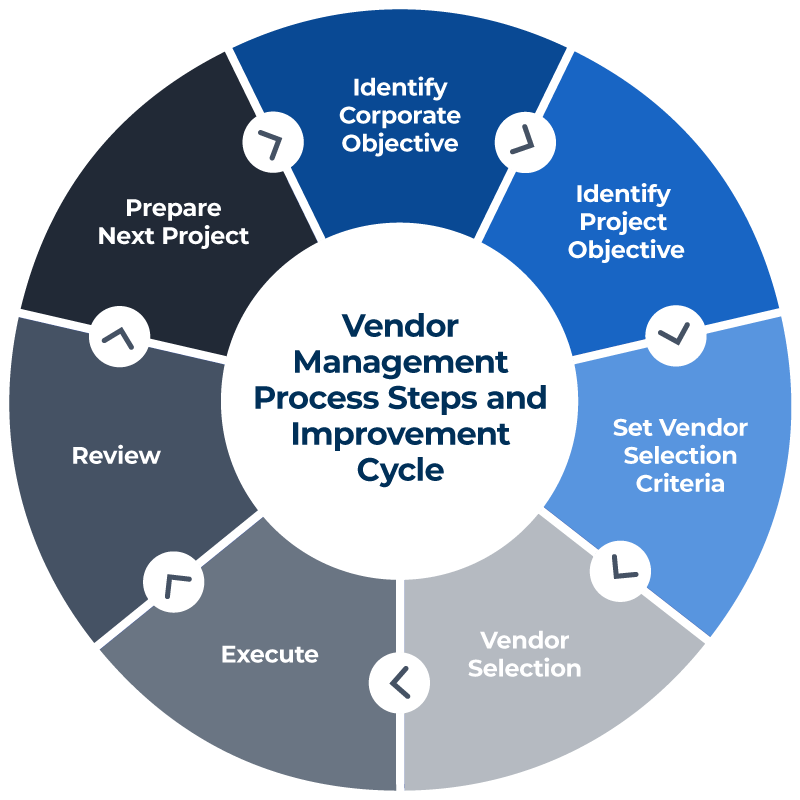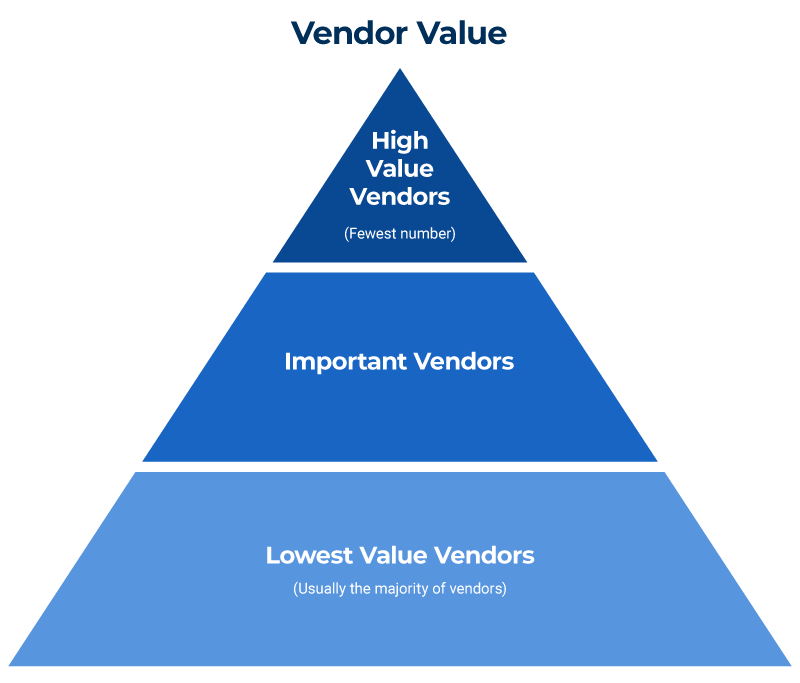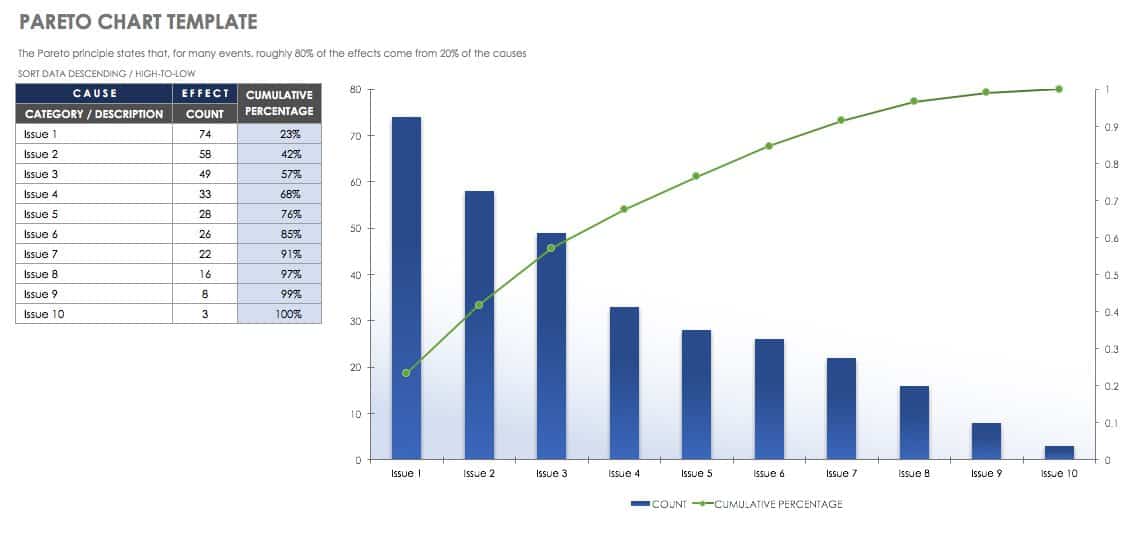What Is the Vendor Management Process?
The vendor management process is a series of strategic and tactical activities that companies use to manage and collaborate with vendors. This includes setting objectives, establishing vendor selection criteria, negotiating contracts, strategizing for risk reduction, and controlling for cost and delivery.
Gerard Blokdyk, CEO of The Art of Service and author of Effective Vendor Management: A Complete Guide, says siloed purchasing departments are a remnant of the past. “It's imperative to build a disciplined vendor management process that integrates with overall corporate goals,” says Blokdyk.
If a strategic approach to managing suppliers is new to you and your team, learn more with “The Definitive Guide to Vendor Management.”
Who Uses the Vendor Management Process
Depending on the size of your organization, many different people will participate in the vendor management process. In general, the users are the vendor manager, the vendor management team, and the vendors themselves.
Vendor management users include the following:
- Enterprise-Level Management: The company uses key performance indicators (KPIs) to define and monitor its goals. Key vendors help achieve those goals by supplying products and services with the lowest possible risk level. The C-suite is a strategically oriented organization that will track critical vendor data provided by the vendor management or purchasing team to ensure continuous, smooth, and effective unit maintenance.
- Vendor Managers: The team leaders help create the process and programs, as well as ensure that vendor selection, oversight, execution, and delivery follow the process standards.
- Vendor Management Team: The team should have a thorough understanding and grounding in the strategy behind the vendor management process, as well as any specific tactics. From there, they can carry them through from the beginning to the end of vendor engagements.
- Vendors: A transparent vendor management process establishes relationship requirements, when vendors can expect intervention — or, potentially, rewards for positive actions, such as early deliveries, cost savings, ideas for innovation, or ways to improve existing systems.
In essence, every department in a company should care about vendor performance, since failure in a supply chain can cause anything from minor problems (e.g., a delay in a production line due to late materials) to significant issues (e.g., those that can damage sales, goodwill, and reputation).
How to Build and Establish a Vendor Management Process
A strong vendor management process should focus on company objectives and gain C-suite buy-in. The process itself encompasses all the steps from vendor selection through the end of the relationship, with risk mitigation at top of mind.
Vendor management enables organizations to gain increased value from their vendors throughout the relationship lifecycle. The vendor management process defines the specific practices you put into action.
The overall process drivers of vendor management include company-wide goals and KPIs, the ability to work collaboratively with key vendors, and dedication to continuous improvement.
Vendor Management Process Steps and the Improvement Lifecycle
The vendor management process involves seven steps, including incorporating corporate objectives, defining the vendor or specific project objective, setting vendor selection criteria, selecting a vendor, formalizing the contract, reviewing the project, and refining the process.
Jon M. Quigley, author and a Principle at Value Transformation, LLC, applies a framework that emphasizes continuous improvement. “It is a complicated process, and that requires customization to fit your particular organization and buying situation,” Quigley emphasizes. “You learn with every engagement and situation how to refine the process and better mitigate risk. You do that by collecting data and applying that knowledge to the next situation and the process in its entirety.”
This method applies to the vendor management process system design overall and to individual projects that vendor managers undertake when using the process.
- Identify Corporate Objectives: Corporate KPIs should be the overriding factor in any vendor relationship. “You should work in alignment with KPIs,” says Quigley. “Then decide which combination of options meets your organization's requirements, provides the greatest value, and is the most cost effective on a lifecycle basis.”
- Identify the Project Objective: Blokdyk of The Art of Service suggests the following questions to help you determine the project objective. “What needs to be done to achieve or close the gap between the present state and the corporate objective? How does the project move us closer to the corporate objective? What does project success look like?”
Document and include the answers to these questions in a statement of work (SoW) or project charter, both of which provide the project objectives.
“In the vendor management process,” says Quigley, “projects are temporary endeavors that efficiently and cost-effectively advance the organization's goals as they reduce risk. Project objectives direct specific vendor objectives, which in turn translate to individual vendor performance and predictive metrics. These then feed into the work’s execution portion as a feedback loop. These metrics help the team learn how to adapt the work methods.” - Vendor Selection Objective: “Translate the success factors you’ve identified into a list of supplier selection criteria,” advises Quigley. “Build a database for all vendor-related information, or use vendor management software to centralize the data for collaboration.” Vendors don’t provide equal value to the company. The focus should be on vendors that are the most valued as relevant to corporate goals.
- Vendor Selection: Consider three major areas in vendor selection: First, determine their value to your company; second, examine their profile in multiple dimensions; and third, perform a risk assessment. For more ways to select vendors and another expert point of view, refer to the “Vendor Assessment and Evaluation Simplified.”
- Potential Value: Classify all potential vendors based on their importance to your company. High-value or tier-one vendors are single source, providing top value but low in number. Secondary vendors have multiple sources and offer value, but less so than tier-one vendors. Tertiary vendors are easy to come by and replace; they also have low weight and are high in number. Nurture top-tier relationships more than "bottom of the pyramid” vendors; the latter are easy to replace and hold a more transactional position in the vendor hierarchy.
- Profiling and Due Diligence: With a focus on the highest-value vendors, perform your due diligence and create a profile for each candidate. Review financial condition, business approach, marketing, reputation, cost factors, and location. In addition, interview current and past customers.
- Risk Assessment: Due diligence will touch on risk, but to ensure your company’s position, review risk factors in every dimension before you contract a new vendor or negotiate with an existing vendor. Risk assessment should cover the following: failure or delay risk, which is the inability to deliver a product or service as contracted; brand reputation risk, such as product recalls or poor affiliations; competitive advantage risk, such as security breaches or intellectual property theft; price and cost risks, such as soft pricing or commodity price hikes; quality risks, such as product failure or poor service. For more information and free templates on risk assessment, including a vendor risk assessment template, read “Simplified Guide to Vendor Risk Assessment.”
You can also use this template to create a risk ranking of all potential vendors.
Compile all your findings and vendor rankings, and make them available to your review team for assessment and discussion. An easy way to assess and evaluate vendors is by using a risk scorecard as a strategic tool. Find templates and information in “Vendor Scorecard Criteria, Templates, and Advice.”
- Potential Value: Classify all potential vendors based on their importance to your company. High-value or tier-one vendors are single source, providing top value but low in number. Secondary vendors have multiple sources and offer value, but less so than tier-one vendors. Tertiary vendors are easy to come by and replace; they also have low weight and are high in number. Nurture top-tier relationships more than "bottom of the pyramid” vendors; the latter are easy to replace and hold a more transactional position in the vendor hierarchy.
- Execute: In this step, the real work begins. This includes everything from onboarding and contracting to collaboration, oversight, and delivery.
- Onboarding and Contracting: Vendor onboarding is the process that enables companies to collect documentation and data to approve and contract vendors, purchase services or goods, and make payments. The clarity these steps provide sets the stage for excellent relationships and ongoing success. Onboarding is also efficient to share your organization’s processes, practices, compliance standards, and expectations. To understand the full dimensions of onboarding and access templates, read the “Complete Guide to Streamlining Vendor Onboarding.”
- Active Management: As your vendors begin their work, it’s essential to monitor performance and output. Those responsible for managing the vendor will monitor the relationship to ensure that contract terms are fulfilled. If your vendor is delivering an item of high importance to your company, you might want to monitor the relationship daily. This involves lots of communication to offer approvals, disapprovals, changes, feedback, and whatever else is necessary to deepen the relationship. The easiest way to facilitate this monitoring level is with VMS software that has reporting capabilities and two-way communication features.
- Delivery: Whether the deliverable is a single event or delivery of products or services over time, the responsible vendor management team member at your company oversees and ensures that contract agreements are complete before sign-off and final payment.
- Project Review: “A thorough post-mortem of compiled project data gives you a solid mechanism to compare the effort to the objective,” recommends Quigley. “The information tells you where things may have gone awry. It also tells you what to repeat to achieve objectives with the next project.” For more ideas and tools, use the resources in “How to Master Vendor Performance Management.
Download Pareto Chart Template - Microsoft Excel
7. Prepare for the Next Project or Vendor: Continuous improvement is a vendor management process best practice, as previous engagements are the basis of future relationships, metrics, and standards that become best practices in your vendor management work. Use the data you collect from vendor projects to analyze what went well, what went wrong, what to change, and what to watch for in new projects. If contracts are up for renewal with existing clients, use your data and provable insights as part of the basis of contract renegotiation.
How Do You Implement a Successful Outsourcing Process?
The key to successfully implementing an outsourcing process is to ensure business continuity and cost controls. The experts you hire should understand your specific goals before any work begins, and their work should be monitored on a continuous basis.
“Everyone should work from the same playbook when you outsource,” states Quigley. “Your selected vendors are the experts in their area. Tap into that expertise to give your business a competitive advantage, particularly if they participate in the decision-making meetings and strategies are established. Be sure that you have an appropriate NDA in place before any meetings of this sort take place with the vendor.”
For more information to take procurement to the next level, see the “Everything You Need to Know about Business Process Outsourcing.”
Benefits of the Vendor Management Process
The many benefits of the vendor management process fall into six general categories: value generation, compliance and risk reduction, improved performance, effectiveness, and innovation.
The vendor management process enables companies to do the following:
- Drive Strategic Objectives: When you manage vendor relationships as collaborative partnerships based on high-level organizational requirements, you enable competitive advantage, such as innovation, increased capacity, knowledge sharing, and complementary offerings.
- Minimize Risk: Relying on vendors to deliver goods and services saves money and time and staffing costs, but it also comes with risk. Design your vendor management process to mitigate operational, compliance, financial, and other threats to your company — it will be easier when you select and oversee vendors from that perspective.
- Set Appropriate Evaluation and Ongoing Review Criteria: All aspects of vendor expectations, such as risk mitigation, pricing, turnaround times, and quality standards, should be decided upon based on a framework informed by needs and data analysis.
- Develop Contract Negotiation Strategies: Strong negotiation with vendors result from a thoughtful analysis that supports an overall company strategy. With critical vendors, in particular, you want to set up a win-win situation that fosters collaboration.
- Forge Productive Relationships: When you work cooperatively with vendors, you create more stable and effective relationships for the longer term. Changing vendors costs time and money — it's better to “get it right” from the beginning of the relationship. This relationship-driven approach is different from the traditional purchasing office approach, which often focuses on cutting costs and stepping up delivery times and can lead to severed relationships rather than cooperation.
- Define Roles and Responsibilities: When you offer clarity about who is in charge of different aspects of vendor relationships and communication channels, you create overall efficiency.
Importance of the Vendor Management Process
The vendor management process unlocks the full — and often hidden — value of your suppliers. Efficiency increases, and the process’s collaborative orientation benefits your company beyond cost savings.
Vendor management is a business discipline that is gaining traction with organizations across a variety of industries now that the world is a single network connected in real time by global trade and technology. No matter what type of business you’re in, from banking to manufacturing to retail, vendor management processes become a bottom-line contribution source when aligned with other strategic business aims and company departments.
Your vendor management process and programs’ size and complexity should scale to your organization’s appropriate level of maturity. As you evaluate how to right-size a vendor management program, consider expert information and tips found in “Design Your Vendor Management Program.”
Vendor Management Process Best Practices and Tips
Vendor management process best practices and tips generally fall into several groups: setting a framework, practicing term communications, collecting data, being risk-aware, and focusing on collaboration and long-term relationships.
- Use Quantitative Data Collection Approaches: “Allow your organization flexibility to use a quantitative approach to make significant decisions,” suggests Blokdyk. “For example, complex products hold millions of computer code lines — does the vendor have automated code scanning environments to automatically test for coding practice as part of their R&D process? What processes does the vendor have to ensure that no customer data exists on disks or storage before landing in a return center? Let the data be your guide to make meaningful improvements.”
- Rely on Your Framework: “Have mechanisms and vendor management processes in place for your organization that encourage choice and vendor neutrality,” Blokdyk says. “Don’t rely on a ‘who you know’ or ‘who is cheapest’ approach.”
- Strive for Long-Term Relationships: Working with vendors long-term saves time and money, but remain vigilant. Collect data to confirm that you’ve made the right choice, and if you see a glitch, confer with your vendor and make course corrections as needed.
- Be Risk Aware: This aligns with the previous best practice: You simply cannot drop your guard. Ensure that you are alert to risks with your vendors and threats in the environment, like global shipping issues, data breaches, or other hazards.
- Compile Your Own Vendor Management Best Practices List: Use all the information and experience you gather to write your own best practices guide and include it in your onboarding manual.
What Makes for a Good Vendor Manager and Vendor Management?
A good vendor manager is clear about expectations, operates in good faith with their vendors and partners, is detail-oriented, maintains open lines of communication, and most important, always keeps company goals top of mind.
Good vendor management is a right-brain/left-brain proposition, as are most management jobs. Use data to check performance and drive improvement, but be aware of the additional creative aspect that involves dealing with and encouraging your team. Partner with your vendors to see if you can spark some new ideas, products, or services that could be a game changer for both parties.
Vendor Management Process Negotiation Tips
Vendors are people. Negotiation is an effort to reach an agreement, not necessarily a competition, to see who can beat their opponent. A preferred goal is to create a partnership and an environment in which everyone contributes to the success, and everyone wins. Below are some tips for different aspects of negotiating with vendors:
Relationship
- Establish Rapport: Speak often, understand your counterpart, and meet in person if you can.
- Speak Their Language: Learn your vendor’s jargon and take the time to understand their business, and vendors will respond with respect. The credibility and trust you create will set the terms for your partnership (and potentially result in more favorable rates).
- Seek a Win-Win: Spend time to discover the vendor's goals to help you find a better way to a mutual, beneficial agreement.
Due Diligence
- Know Actual Costs: Do your homework before you start talking numbers. Be armed with facts, and check the competition and industry standards for reasonable rates.
- Quiz Their Customers: The best data you can get from a supplier is from their customers.
Money
- Quote Multiple Vendors: Use the rule of three to gain competitive pricing.
- Play the High/Low-Quality Game: Do your research and determine a target dollar amount that you want to pay. Once you get the price, ask the vendor(s) if there is still room for negotiation based on other factors, such as a longer contract.
- Have Your Deposit Ready: If you want to create leverage with a vendor, be ready, willing, and able to make a 50 to 70 percent deposit.
Stance
- Be Prepared to Walk Away: Have backup suppliers ready in case of a deadlock. Doing so will keep you from a scarcity mindset and allow you to come across as confident in any negotiation.
- Reviews are Negotiation Opportunities: Every review meeting is a mini-negotiation, since the interaction usually requires agreement on a course of action, some of which may have cost implications in the present or future.
For more tips you can use, check out the “Guide to Vendor Management Best Practices.”
Vendor Management Process Challenges
For all the benefits the vendor management process brings to companies, there are also challenges to consider. They include ensuring compliance, upholding your reputation, building a process that provides transparency, maintaining adequate data storage, and having clarity around payment policies.
Here are some challenges to be aware of as you develop your vendor management process:
- Complex Vendor and Cyber Ecosystem: If you have hundreds (or even thousands) of vendors, it will be challenging to manage them all effectively. VMS can take out some of the pain of managing multiple contracts, deadlines, quality, compliance, and invoicing issues.
- Having the Right Internal Resources: Even with a VMS, many vendors or purchasing offices are understaffed to handle critical relationships.
- Top-Down Buy-in and Adherence: Vendor management as a strategic business practice is impossible without C-suite endorsement.
- Multiple Risk Factors: No matter how sophisticated your vendor management practice might be, risks always exist. Risk mitigation and planning are a significant part of the vendor management job, and assessing risks need to be part of any relationship (before entering into it, during the relationship, and even after the vendor relationship ends).
- High Administrative Costs: Having the right people, processes, and tools in place come at a price. A VMS offers improved visibility and can improve efficiency and resource allocation.
- Data Breaches: Data drives business, but there is always a possibility that the information will leak. As all business functions move online, guarding against cyberattacks is the top concern.
The challenges of vendor management tend to grow along with your company’s size and the number of vendors you employ. Another category is IT vendor management, which has its own challenges and complications.
Important Vendor Management Process Terms
Below are some standard vendor management process terms to know:
- Vendor Management Office (VMO): This is a business unit dedicated to evaluating goods and services vendors that oversees interactions, ensures that buying activity aligns with corporate goals, and is responsible for long-term vendor relationships. As IT has become more critical to company competitiveness and functions, IT-dedicated VMOs have become more prevalent.
- Vendor Lifecycle Management (VLM): VLM is an end-to-end approach to managing vendors with transparency and structure. In many forward-thinking companies, lifecycle management has taken piecemeal, siloed purchasing by individual departments for greater efficiency and support the overall strategy.
- Vendor Relationship Management (VRM): VRM refers to the process of nurturing relationships with suppliers of services and products. The goal is to ensure smooth operations by delivering quality services and products promptly that meet or exceed their contractual obligations.
- Vendor Management System (VMS): These are software suites that help businesses take care of processes involved in the end-to-end vendor management process, from initial contact to final closure of a deal or the establishment of a business relationship. A VMS usually has apps or specific modules dedicated to processes like onboarding, time tracking, delivery monitoring, invoicing, and payments.
- Vendor Insourcing: This refers to charging company departments and personnel to deliver services or products. Companies with multiple subsidiaries might use one subsidiary to support another.
- Vendor Outsourcing: Outsourcing is the hiring of unaffiliated external organizations to complete specific tasks. Vendor outsourcing works in a variety of business settings, from retail to entertainment to manufacturing.
- Vendor on Premises (VOP): This is an exclusive, long-term general contractor relationship with a separate company that provides products or services on the hiring company’s premises. The VOP might also subcontract other vendors on an as-needed basis, with the approval of the hiring entity. Large-scale manufacturers often rely on VOPs.
- Managed Service Provider (MSP): MSPs outsource the responsibility for anticipating and maintaining a range of functions and processes to improve operations and cut expenses. MSPs are often the providers of specialized IT services.
- Employer of Record (EOR): An organization assumes legal responsibility for all aspects of human resources and acts as its employees’ employer. EORs keep the business in compliance with regulations, labor laws, and other types of legal restrictions. In international scenarios, regulations regarding benefits, taxes, and compliance can be complex. Tech companies use EORs to hire staff under work visas.
IT Vendor Management Process
The IT vendor management process is different from managing regular vendors. Increasingly, IT is of higher importance and value to companies. Simultaneously, data-related risk and the constant evolution of needs and requirements can make IT a management challenge.
Companies of all sizes might have difficulties handling IT needs. To help with the sheer volume of work, vendors (sometimes many of them) are a necessity. To manage IT vendors successfully, many companies now have IT VMOs with a staff with a comprehensive understanding of technology, contracts, and finance.
In addition to all the contractual, technical, and financial issues, VMOs follow a vendor management process to manage risk, performance, and relationships, just like their vendor management peers. “IT vendor management strengthens service, contains costs, and reduces risk to extract the highest value from the investment,” says The Art of Service’s Blokdyk. “Value is all about technology implementation using the right policies, processes, and procedures to support your business needs.”
“Most IT vendors must work from an underlying service-level agreement (SLA),” explains Blokdyk. “These define the relationship and anticipate issues and how to deal with them. The SLA’s incident management process workflow defines that the vendor is responsible for communicating outages, incidents through tickets, emails, and SLA response times.”
Here are some IT vendor management tips from Blokdyk:
- Be Prepared for Disaster: “Take every possible precaution before you entrust data, business continuity management, or incident management to a vendor,” warns Blokdyk. “Make sure that a failure of a vendor's systems or processes won’t cause significant impacts to your company or your clients’ business processes, and doesn’t interrupt the revenue stream.”
- Pick Up the Pace of Data Analysis: Collect and analyze vendor evidence daily. Focus on risk analysis and necessary remediation. Establish a process to resolve disputes between your organization and its vendors.
- Build In Sub-vendor Management and Responsibility: Insist on knowing about your vendor’s subcontractors and how they handle critical cybersecurity and legal issues that might affect your organization.
ITIL Vendor Management Process
The Information Technology Infrastructure Library (ITIL) is a framework or best practices foundation for IT management. ITIL focuses on improving IT services, including the design, creation, delivery, support, and management of IT to align with business needs.
ITIL originated as a series of IT organization guidelines, and many technology professionals are ITIL certified. As IT has grown in every business vertical and adopted technology into their workflows, non-IT organizations leverage the framework as a method to reduce risk, reduce business disruption and failure, increase IT efficiency, and increase competitive advantage.
VMOs at companies that deal extensively with IT vendors find the framework and best practices useful, and many non-IT companies in the United States also use ITIL. Adopters include Boeing, Procter & Gamble, Sony, Staples, Target, Walmart, Nationwide Insurance, Toyota, UnitedHealth Group, Pfizer, Visa, and PEMCO.
Benefits and Key Considerations when Using Cloud-based Software for Your Vendor Management Process
Cloud-based tools are scalable, integrate easily with operational tools you already have, and save time and money. They are often a strong option for companies looking for a software solution to support their vendor management process.
| Audit log | Track all engagement with vendors and log all activities in a centralized activity book. |
| Central data repository | A central repository stores all vendor-related information, including financials, contracts, SLAs, and compliance certificates. |
| Communication and collaboration | Initiate contract negotiations, and promote an engaged client-vendor relationship with messaging and information exchange. |
| Due diligence and risk evaluation | Validate vendors based on pre-approved criteria, such as required certifications, location, and financial metrics. |
| Ease of deployment and compatibility | Check whether you will be required to purchase new or extra equipment and if the software will integrate with tools you already use. Look into the necessary level of training and how it will impact employees and vendors. |
| Onboarding and compliance | Get new vendors up to speed on practices and policies while also checking federal and state compliance regulations. |
| Payment and invoicing | Track billable hours, payments, and billing information necessary for accurately completing vendor transactions. Generate purchase orders, requisitions or procurement, third-party billing, and invoicing. |
| Performance monitoring and metrics | Continuously monitor the performance of existing vendors against SLAs and metrics. |
| Self-service portal | The portal is an online gateway for system access that allows vendors to perform tasks permitted by the system owner. |
Does VMS justify the cost? That depends on the current number of current vendor relationships. If you haven't had any problems connecting your business with reliable, trustworthy vendors and keeping the management process on track, you might not need to invest. However, if your business is on the verge of scaling up, you'll need a system that enables you to manage added complexity and a significant number of vendors.
To learn more about buying vendor management software, refer to “How to Choose Vendor Management Software.”
Streamline Your Vendor Management Process with Real-Time Work Management in Smartsheet
Empower your people to go above and beyond with a flexible platform designed to match the needs of your team — and adapt as those needs change. The Smartsheet platform makes it easy to plan, capture, manage, and report on work from anywhere, helping your team be more effective and get more done. Report on key metrics and get real-time visibility into work as it happens with roll-up reports, dashboards, and automated workflows built to keep your team connected and informed. When teams have clarity into the work getting done, there’s no telling how much more they can accomplish in the same amount of time. Try Smartsheet for free, today.




